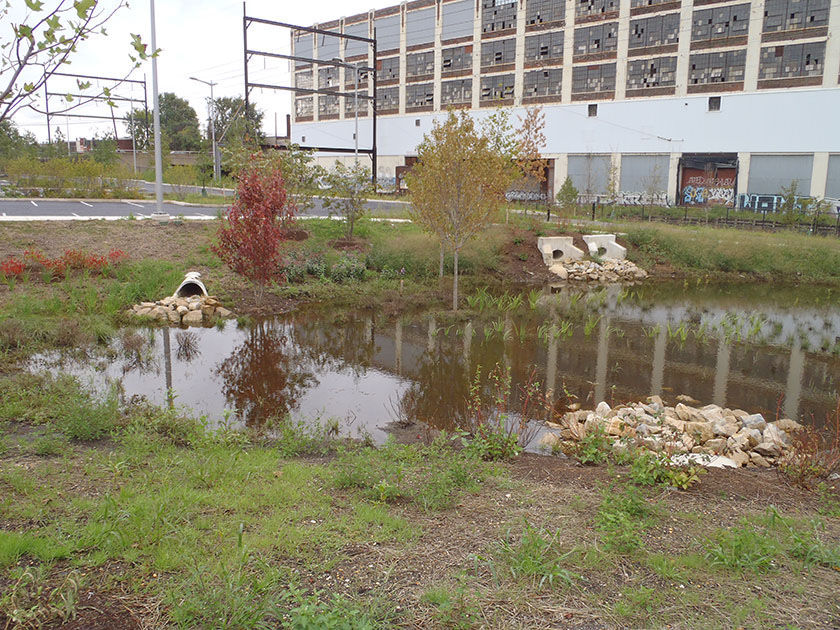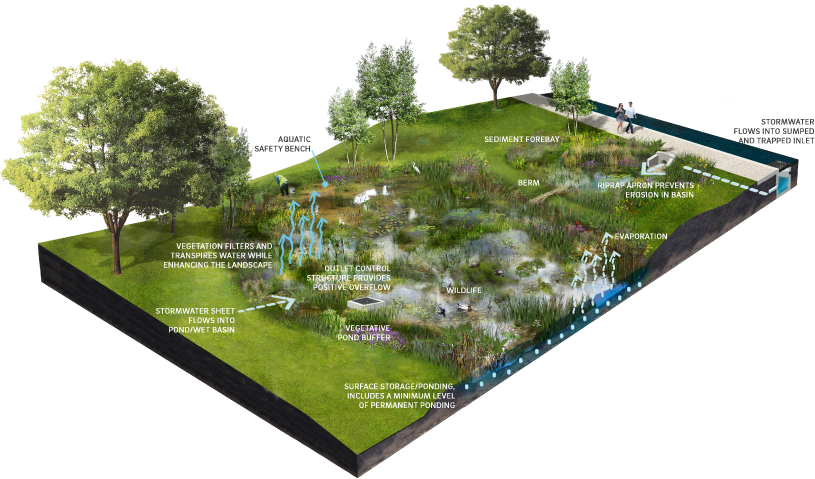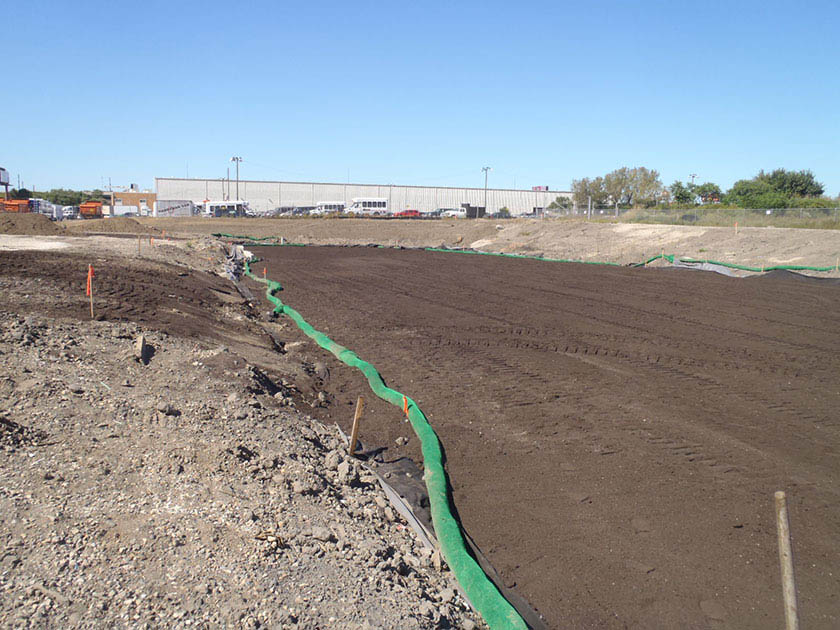Download summaries of this SMP and its maintenance guidance, with quick reference information for clients and developers:
Ponds and Wet Basins SMP One-Sheet
Ponds and Wet Basins Maintenance Guidance One-Sheet
4.7.1 Pond and Wet Basin Introduction
Ponds and wet basins are earthen depressions constructed with a substantial permanent water pool to provide both temporary and long-term storage of stormwater runoff, and they can be used to attenuate peak flows and provide Water Quality treatment through both pollutant removal and slow release. These stormwater management practices (SMPs) attenuate peak flows through the use of an outlet control structure and provide storage capacity above the permanent pool, while water held within the system, including the permanent pool, is treated through a variety of physical, chemical, and biological processes. Wet basins can also achieve minimal volume reduction through evapotranspiration.
Quick Tip
Required pond and wet basin design and material standards are denoted in this Section by easy-to-reference numerals.
Wet basins are relatively effective at removing many common stormwater pollutants including suspended solids, heavy metals, total phosphorus, total nitrogen, and pathogens. The pollutant removal effectiveness varies by season and may be affected by the age of the wet basin. Detention basins are similar in function to ponds and wet basins with the exception that they lack these water quality benefits and are primarily used for peak rate control and extended detention.
Design of ponds and wet basins is not limited to the examples shown within this text. Successful stormwater management plans will combine appropriate materials and designs specific to each site.

When Can Ponds and Wet Basins Be Used?
Ponds and wet basins are capable of managing runoff in a variety of different settings, provided there is adequate space available for the SMP. They require a connection with shallow groundwater or a sufficient source of inflow to maintain the permanent pool.
Key Advantages of Ponds and Wet Basins
- Can be effective at providing Water Quality requirement treatment and flow attenuation while also providing aesthetic amenities and wildlife habitat
- Can easily be converted from a dry detention basin
- Can contribute to better air quality and help reduce urban heat island impacts
- Can provide educational benefits, especially when used at public and/or highly visible sites such as schools, recreation centers, libraries, etc.
Key Limitations of Ponds and Wet Basins
- Require a dedicated, large ground surface area
- May contain deep water, which can pose a safety hazard and may require fencing to restrict access
- Can sometimes attract geese and other wildlife that may conflict with the intended site use of surrounding areas
- Can provide a mosquito breeding habitat along shallow edges if not designed appropriately
Key Design Considerations for Ponds and Wet Basins
- A berm placed on the downslope side of a mild slope can function as a forebay, helping retain stormwater and increasing capacity without additional excavation. The designer is referred to Section 4.10, Pretreatment, for more information on forebays.
- Secondary benefits, such as wildlife viewing areas and walking paths, can be incorporated into wet basin designs to enhance their value.
- Robust and diverse vegetation should be used along the perimeter of the pond to provide a buffer from surrounding areas.
- Smart plant selection for the site should be a focus. It is critical that plant materials are appropriate for soil, hydrologic, light, and other site conditions. The designer is referred to the list of native species in Appendix I. Ponding depth, drain down time, sunlight, salt tolerance, and other conditions should be taken into consideration when selecting plants. Turf grass is generally not recommended but may be acceptable provided the designer can demonstrate that it meets all applicable requirements. The designer is referred to Section 4.13, Landscaping, for additional landscaping guidance.
- For any pond or wet basin that discharges onto an adjacent property, a drainage easement may be required and is recommended.
4.7.2 Pond and Wet Basin Components
Figure 4.7‑1: Ponds and Wet Basins with Typical Features

Pretreatment Component
Pretreatment systems capture trash, sediment, and/or other pollutants from stormwater runoff before delivery to the storage area. Pretreatment needs will vary significantly depending on the contributing drainage area composition and use. Pretreatment can include structures such as sumped and trapped inlets, sediment/grit chambers or separators, media filters, inlet inserts, or other appropriate prefabricated or proprietary designs to remove sediment, floatables, and/or hydrocarbons from stormwater runoff prior to introduction to a pond or wet basin.
Pretreatment can also consist of filter strips, forebays, and swales. The designer is referred to Section 4.10, Pretreatment, for more information on pretreatment systems.
Inlet Control Component
Inlet control systems convey and control the flow of stormwater from the contributing catchment area to a pond or wet basin. Inlet control needs will vary depending on the design of stormwater conveyance systems and the site layout. The designer is referred to Section 3.4.2 for guidance on stormwater conveyance system design.
Inlet controls may include flow splitters, curbless design/curb openings, energy dissipaters, and inlets. The designer is referred to Section 4.11, Inlet Controls, for more information on inlet controls.
Storage Area Component
Storage areas within ponds and wet basins temporarily hold stormwater runoff until it can either evaporate, be used by plants through evapotranspiration, or be released downstream at a controlled rate, depending on the system design. The storage component of a pond or wet basin is provided typically by either excavating an area to create a depression, or by constructing berms around a low-lying area to create an impoundment. Ponding time provides water quality benefits by allowing larger debris and sediment to settle out of the water.
Storage areas within ponds and wet basins are designed with aquatic/safety benches. An aquatic/safety bench is a shallow, graded area that extends inward from the perimeter of the permanent pool boundary. This bench provides valuable wildlife habitat area and helps to minimize safety risks associated with the permanent pool by providing a shallow perimeter zone.
A pond buffer should extend outward from the permanent pool boundary in order to enhance habitat potential, improve aesthetics, reduce water temperatures, and improve overall pond health.
Vegetation Component
Plant material in a pond or wet basin removes nutrients and stormwater pollutants through vegetative uptake and microbial community support, removes water through evapotranspiration, improves aesthetics, provides wildlife habitat, and helps to stabilize soil. Vegetation in and around a pond or wet basin also provides algal control and cooler water temperatures. The designer is referred to Section 4.13, Landscaping, for more information on landscaping.
Outlet Control Component
Outlet controls within a pond or wet basin can provide a range of functions, including the following:
- Meeting drain down time requirements;
- Controlling the rate of discharge from the SMP and limiting water surface elevations during various storm events; and/or
- Bypassing of flows from large storm events.
Outlet controls may include orifices, weirs, risers, level spreaders, or impervious liners. The designer is referred to Section 4.12, Outlet Controls, for more information on outlet controls.
Inspection and Maintenance Access Component
Safe and easy inspection and maintenance access to all major components within a pond or wet basin is critical to ensuring long-term performance. Mildly sloping, stabilized, graded areas can provide access to surface storage areas for heavy equipment, which may be needed for sediment removal.
4.7.3 Pond and Wet Basin Design Standards
General Design Standards
- The maximum allowable drain down time is 72 hours after the 24-hour storm event.
- Positive overflow must be provided for large storm events, up to and including the 100-year, 24-hour storm event, or, if the project is exempt from Flood Control, the ten-year, 24-hour storm. Overflow structures and pipes must be designed to convey at least the ten-year, 24-hour storm.
- The minimum allowable freeboard between the peak storage elevation during the 100-year, 24-hour storm event and the emergency spillway invert elevation is one foot.
- The minimum allowable distance between the emergency spillway crest elevation and the top-of-berm elevation is one foot.
- The minimum allowable basin length-to-width ratio is 2:1.
- The minimum allowable basin width is ten feet.
- The minimum allowable sediment forebay length is ten feet.
- The distance between the basin inflow and outflow points must be maximized.
- A Natural Resources Conservation Service curve number of 98 must be used for the area below the water surface elevation, where required for hydrologic calculations.
- All areas deeper than four feet must have two aquatic safety benches extending a combined total of 15 feet, at minimum, inward from the perimeter of the basin. One bench must be above the normal water surface elevation and extend up to the pond side slopes at a maximum slope of 10%. The other bench must be below the water surface extending into the pond at a 10% slope to a maximum depth of 18 inches.
- A dewatering mechanism must be provided for facilities that are not in connection with groundwater.
Pretreatment Design Standards
- Acceptable form(s) of pretreatment must be incorporated into design. Pretreatment of runoff from all inlets is required. At a minimum, this can be achieved through the use of sumps and traps for inlets, sump boxes with traps downstream of trench drains, and filter strips for overland flow.
- The designer is referred to Section 4.10, Pretreatment, for more information on design standards for pretreatment systems.
Inlet Control Design Standards
- To prevent erosion, energy dissipaters, such as riprap stone, must be placed at all locations of concentrated inflow. Riprap aprons must be designed, and stone sizing must be determined, in accordance with the riprap apron design procedures in the latest edition of the Pennsylvania Department of Environmental Protection (PA DEP) Erosion and Sediment Pollution Control Program Manual.
- The designer is referred to Section 4.11, Inlet Controls, for more information on design standards for inlet control systems.
Storage Area Design Standards
- The storage area must provide static storage for the Water Quality Volume (WQv) between the overflow elevation and the basin’s water surface. All permanent pool areas must be excluded from the SMP’s storage volume estimation. The minimum allowable ponding depth below the lowest outlet device is three inches.
- Ponds and wet basins can be designed with additional storage beyond the WQv and with outlet controls that allow all remaining applicable Philadelphia Water Department (PWD) Stormwater Regulations (Stormwater Regulations) to be met.
- Maximum side slopes for open storage areas as follows:
- All – 2(H):1(V) (The recommended side slope is 3(H):1(V))
- Mowed- 4(H):1(V) to avoid “scalping” by mower blades
- A minimum planting soil medium depth of 18 inches must be provided (under emergent planting zones only). The planting soil medium may be composed of on-site soils.
Vegetation Design Standards
- Plantings must be designed to minimize the need for mowing, pruning, and irrigation.
- Plants and trees that are appropriate for, and compatible with, the site conditions must be chosen. The designer is referred to Appendix I for plant lists and to Section 4.13, Landscaping, for more information on landscaping.
- Care must be taken to ensure that the ponding area depth is appropriate for the size and species of the plants selected.
- The planting design must provide for at least 85% cover of the emergent vegetation zone (the area of the pond that is less than 18 inches deep) and buffer area.
- A vegetated pond buffer must extend outward 25 feet from the permanent pool.
- Ponds and wet basins must be planted with species tolerant of a range of inundation depths and periods. A wetland ecologist or other appropriate design professional should be consulted for guidance.
Outlet Control Design Standards
- Energy dissipaters, such as riprap stone, must be placed at the end of the primary outlet to prevent erosion. Riprap aprons must be designed, and stone sizing must be determined, in accordance with the riprap apron design procedures in the latest edition of the PA DEP Erosion and Sediment Pollution Control Program Manual.
- The primary and low-flow outlets must be protected from clogging by an external trash rack.
- The emergency spillway must not direct flow toward neighboring properties.
- The designer is referred to Section 4.12, Outlet Controls, for information on design standards for outlet control systems.
Inspection and Maintenance Access Design Standards
- Stabilized vehicular access must be provided for sediment removal. Areas must be at least nine feet wide, have a maximum slope of 15%, and be stabilized as needed to provide load support for vehicles.
4.7.4 Pond and Wet Basin Material Standards
Pretreatment Material Standards
- The designer is referred to Section 4.10, Pretreatment, for information on materials standards for pretreatment systems.
Inlet Control Material Standards
- The designer is referred to Section 4.11, Inlet Controls, for more information on material standards for inlet control systems.
Storage Area Material Standards
- Planting Soil Medium:
- Hydrologic soil groups “C” and “D” are suitable, without modification, for underlying soils.
- If natural topsoil from the site is to be used, it must have at least 8% organic carbon content by weight in the A-horizon for sandy soils and 12% for other soil types.
- If planting soil is imported, it must be made up of equivalent proportions of organic and mineral materials.
Vegetation Material Standards
- Trees and shrubs must be freshly dug and grown in accordance with good nursery practice.
- Perennials, grass-like plants, and groundcover plants must be healthy, well-rooted specimens.
- A native grass/wildflower seed mix can be used as an alternative to groundcover planting. Seed mix must be free of weed seeds.
- Use of invasive plants is not permitted. All plants and trees must be appropriate and compatible with soil, hydrologic, light, and other site conditions. The designer is referred to Appendix I for plant lists and to Section 4.13, Landscaping, for more information on landscaping.
Outlet Control Material Standards
- The designer is referred to Section 4.12, Outlet Controls, for information on material standards for outlet control systems.
4.7.5 Pond and Wet Basin Construction Guidance
Construction of ponds and wet basins often encompasses substantial excavation and grading activities that require careful oversight to ensure appropriate SMP function. Some general construction guidelines are as follows:
- Pond excavation depths should account for any impervious liners, plant matter, and/or planting soil required.
- The subsoil must be free of hard clods, stiff clay, hardpan, ashes, slag, construction debris, petroleum hydrocarbons, and other undesirable materials and must not be frozen or in a muddy state.
- During all phases of work, including transport and on-site handling, the plant materials must be carefully handled and packed to prevent injury and/or desiccation of the plants. Plant material should be kept from freezing and kept moist, cool, and covered so as to protect the plants from any precipitation, wind, and/or sun. Plants must be watered to maintain moist soil and/or plant conditions until accepted.

4.7.6 Pond and Wet Basin Maintenance Guidance
Maintenance of ponds and wet basins focuses on the periodic removal of sediment and debris from pretreatment and storage areas and prevention of outlet control clogging.
General recommended maintenance activities for ponds and wet basins are summarized in Table 4.7‑1.
Table 4.7‑1: Ponds and Wet Basins Maintenance Guidelines
| Early Maintenance Activity | Frequency |
|---|---|
| Water vegetation at the beginning of each day for eight weeks after planting is completed. | Daily for eight weeks after installation |
| Water vegetation regularly to ensure successful establishment. | Every four days during periods of four or more days without rain, June through August for the 24 months after installation |
| Inspect vegetation for signs of disease or distress. | Biweekly for the first year after installation |
| Inspect inlet controls, outlet structures, and storage areas for trash and sediment accumulation. | Monthly for the first year after installation to determine ongoing maintenance frequency |
| Ongoing Maintenance Activity | Frequency |
|---|---|
| Remove trash and debris from forebay, pond, and outlet structure. | As Needed |
| Remove non-target/invasive vegetation. | As Needed |
| Grassed areas require periodic prudent fertilizing, dethatching and soil conditioning. | As Needed |
| Trees, shrubs, and other vegetative cover will require periodic maintenance such as fertilizing, pruning and pest control. | As Needed |
| Mow/trim detention basin vegetation, excluding aquatic bench and buffer. | As Needed |
| Treat basin for mosquito larvae if stagnant water remains for longer than 72 hours. | As Needed |
| Dredge large volumes of sediment and organic debris from basin and forebay areas. Accumulated sediment must never occupy greater than 50% of the forebay volume. | As Needed At least once every five to ten years* |
| Inspect outlet control structure for clogging. | Quarterly and after every storm greater than one inch |
| Inspect SMP for potential problems, including: subsidence, erosion, cracking, or tree growth on the embankment; damage to the emergency spillway; sediment accumulation around the outlet; inadequacy of the inlet/outlet channel erosion control measures; changes in the condition of the pilot channel; and erosion within the SMP and its banks. | Annually |
| Maintain records of all inspections and maintenance activity. | Ongoing |
| *The frequency of sediment removal depends on site conditions such as soil type and maintenance of site stabilization which influence the sediment load on the SMP. | |
The designer is referred to Section 4.10, Pretreatment, Section 4.11, Inlet Controls, Section 4.12, Outlet Controls, and Section 4.13, Landscaping, for information on maintenance guidance for pretreatment, inlet controls, outlet controls, and landscaping.